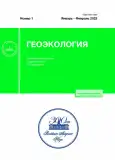BEHAVIOR OF HEAVY METALS IN SOIL-CONDENSATE-PLANTS SYSTEM IN THE ULAN-UDE LANDFILLS
- 作者: Cheredova T.V.1,2, Doroshkevich S.G.1, Bartanova S.V.1
-
隶属关系:
- Dobretsov Geological Institute, Siberian Branch, Russian Academy of Sciences
- East Siberian State University of Technology and Management
- 期: 编号 1 (2023)
- 页面: 50-58
- 栏目: ENVIRONMENT CONTAMINATION
- URL: https://journals.rcsi.science/0869-7809/article/view/139100
- DOI: https://doi.org/10.31857/S0869780923010022
- EDN: https://elibrary.ru/HSAPMS
- ID: 139100
如何引用文章
全文:
详细
The impact of waste dumps on environmental components, i.e., soil, evaporating soil water (condensate) and plants is studied. It has been revealed that industrial and municipal waste dumps continue to affect significantly the environment after their closure. The behavior of heavy metals (Pb, Cu, Zn, Ni, Cd, Co, Sb, Sn, Bi, Hg, and Cr) in soils, plants, and condensate in landfill areas and beyond them (the background) has been studied in detail. It has been found out that soils, plants and condensate at landfills are enriched in heavy metals as compared to the background sites. The degree of soil contamination at waste dumps depends on the reclamation stage of the latter. The landfill soils exceed the norms of maximum permissible concentrations for heavy metals by 1.1–90 times. Concentrations of heavy metals in plants exceed the background values from 1.1 to 104 times at all dumps. The maximum level of heavy metals in plants is exceeded for Zn, Cd, Cr. In the condensate sampled at the dumps, MPC is exceeded for Cu, Zn, and Hg. Based on the analysis results, the geochemical rows of heavy metal distribution in different landfill environments were compiled: in plants – Zn > Cu > Cr >Ni > Pb > Cd > Co > Hg > Sn > Bi; in condensate – Zn > Cu > Ni > Cr > Pb > Sn > Co > > Hg > Sb > Cd > Bi; in the soil – Zn > Cr > Cu > Ni > Pb > Co > Sb = Sn > Cd. The distribution of heavy metals in the condensate and plants is similar. In these environments, contribution of Zn and Cu is more than 80%, contribution of Cr, Ni, Pb varies from 1 to 10%; contribution of Cd, Co, Sb, Sn, Bi, Hg is less than 1%. Heavy metals are distributed in soil according to a different pattern: the main contributors are Zn and Cr (their input is more than 50%), then go Ni, Cu, Co, and Pb (their content in soil varies from 1 to 50%), followed by Sb, Sn, and Cd (their content is less than 1%). Total pollution indices (Zc) of the soil, condensate and plants have been calculated for each landfill. Based on Zc, the landfills were grouped in a ranking series, which can form the basis for assigning the sequence of landfill reclamation measures.
作者简介
T. Cheredova
Dobretsov Geological Institute, Siberian Branch, Russian Academy of Sciences; East Siberian State University of Technology and Management
编辑信件的主要联系方式.
Email: cheredova-tv@yandex.ru
Russia, 670047, Ulan-Ude, ul. Sakhyanovoi, 6a; Russia, 670013, Ulan-Ude,
ul. Klyuchevskaya, 40b
S. Doroshkevich
Dobretsov Geological Institute, Siberian Branch, Russian Academy of Sciences
Email: cheredova-tv@yandex.ru
Russia, 670047, Ulan-Ude, ul. Sakhyanovoi, 6a
S. Bartanova
Dobretsov Geological Institute, Siberian Branch, Russian Academy of Sciences
Email: cheredova-tv@yandex.ru
Russia, 670047, Ulan-Ude, ul. Sakhyanovoi, 6a
参考
- Vinogradov, A.P. Geokhimiia redkikh i rasseyannykh elementov v pochvakh. Polnoe sobranie trudov v 18 t. T. 4 [Geochemistry of rare and scattered elements in soils. The complete works in 18 volumes. Vol. 4.]. E.M. Korobova, L.D. Vinogradova, Eds. Мoscow, RAS Publ., 2021, 298 p. (in Russian)
- Guman, O.M. Ekologo-geologicheskie usloviya poligonov tverdykh bytovykh otkhodov srednego Urala [Ecological and geological conditions of solid waste landfills in the Middle Urals.]. Extended abstract of Doctoral (Geol.-Min.) disseration. Yekaterinburg, UGGU Publ., 2008, 43 p. (in Russian)
- Zhalsaraev, B.Zh., Kutovoi, A.N., Tsynguev, V.G. Rentgenovskii spektrometr [X-ray spectrometer]. Patent RF, no. 2397481, 2010. (in Russian)
- Zaitseva, T.A. Zakonomernosti izmeneniya mikrobiotsenozov na poligonakh deponirovaniya tverdykh bytovykh otkhodov v protsesse destruktsii organicheskikh veshchestv [Patterns of changes in microbiocenoses at landfills of solid household waste deposition in the process of destruction of organic substances]. Extended abstract of Doctoral (Biol.) disseration. Perm, PSU Publ., 2006. 36 p. (in Russian)
- Korsun, O.V. Priroda Zabaikal’ ya: rasteniya [Nature of Transbaikalia: plants]. Chita, Express Publ., 2009, 512 p. (in Russian)
- Kurilenko, V.V., Podplinskii, I.I., Osmolovskaya, N.G. Ekologo-geologicheskaya i bio-geokhimicheskaya otsenka vozdeistviya poligonov bytovykh otkhodov na sostoyanie okruzhayushchei sredy [Ecological geological and biogeochemical assessment of the impact of municipal solid waste landfills on the environment]. Ekologiya i promyshlennost’ Rossii, 2012, no. 11, pp. 28–32. (in Russian)
- Reimers, N.F. Ekologiya. Teorii, zakony, pravila, printsipy i gipotezy [Ecology. Theories, laws, rules, principles and hypotheses]. Moscow, Rossiya molodaya Publ., 1994, 366 p. (in Russian)
- Rin’kis, G.Ya. Optimizatsiya mineral’nogo pitaniya rastenii [Optimization of mineral nutrition of plants]. Riga, Zinante Publ.,1972, 355 p. (in Russian)
- Filippova, L.A. Yurkova, I.V. Geokhimicheskoe vliyanie malykh svalok na okruzhayushсhuyu sredu [Geochemical impact of small landfills on the environment]. Izvestiya SO RAEN. Geologiya, poiski i razvedka rudnykh mestorozhdenii, 2009, no. 34, pp. 92–106. (in Russian)
- Jarvis, S.C., Robson, A.D. Absorption and distribution of copper in plants with ssufficient or deficient supplies. Annals of Botany, 1982, vol. 50, no. 2, pp. 151–160.
- Kabata-Pendias, А. Trace elements in soils and plants. London, New York, CRC Press, Taylor and Francis Group, Boca Raton, 2011, 505 p.
- Schiopu, A.-M., Gavrilescu, M. Municipal solid waste landfilling and treatment of resulting liquid effluents. Environmental Engineering and Management Journal, 2010, vol. 9, no. 7, pp. 993–1019.
- Vaverkova, M.D., Adamcova, D., Zloch, J., Radziemska, M., et al. Impact of municipal solid waste landfill on environment – a case study. Journal of Ecological Engineering, 2018, vol. 19, no. 4, pp. 55–68.












